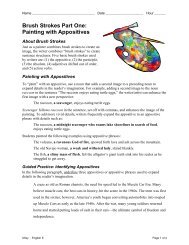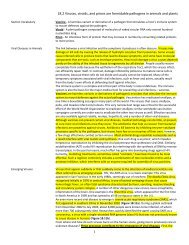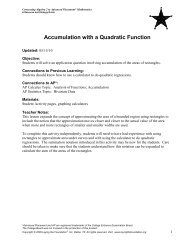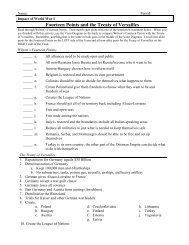10.4 Alternative mechanisms of carbon fixation have evolved in hot ...
10.4 Alternative mechanisms of carbon fixation have evolved in hot ...
10.4 Alternative mechanisms of carbon fixation have evolved in hot ...
Create successful ePaper yourself
Turn your PDF publications into a flip-book with our unique Google optimized e-Paper software.
<strong>10.4</strong> <strong>Alternative</strong> <strong>mechanisms</strong> <strong>of</strong> <strong>carbon</strong> <strong>fixation</strong> <strong>have</strong> <strong>evolved</strong> <strong>in</strong> <strong>hot</strong>, arid climates<br />
Section Vocabulary C 3 plant - A plant that uses the Calv<strong>in</strong> cycle for the <strong>in</strong>itial steps that <strong>in</strong>corporate CO 2<br />
<strong>in</strong>to organic material, form<strong>in</strong>g a three–<strong>carbon</strong> compound as the first stable<br />
<strong>in</strong>termediate.<br />
P<strong>hot</strong>orespiration - A metabolic pathway that consumes oxygen, releases <strong>carbon</strong><br />
dioxide, generates no ATP, and decreases p<strong>hot</strong>osynthetic output; generally occurs on<br />
<strong>hot</strong>, dry, bright days, when stomata close and the oxygen concentration <strong>in</strong> the leaf<br />
exceeds that <strong>of</strong> <strong>carbon</strong> dioxide.<br />
C 4 plant - A plant that prefaces the Calv<strong>in</strong> cycle with reactions that <strong>in</strong>corporate CO 2<br />
<strong>in</strong>to a four–<strong>carbon</strong> compound, the end product <strong>of</strong> which supplies CO 2 for the Calv<strong>in</strong><br />
cycle.<br />
Bundle–sheath cell - A type <strong>of</strong> p<strong>hot</strong>osynthetic cell arranged <strong>in</strong>to tightly packed sheaths<br />
around the ve<strong>in</strong>s <strong>of</strong> a leaf.<br />
Mesophyll cell - A loosely arranged p<strong>hot</strong>osynthetic cell located between the bundle<br />
sheath and the leaf surface.<br />
Crassulacean acid metabolism (CAM) - A type <strong>of</strong> metabolism <strong>in</strong> which <strong>carbon</strong> dioxide is<br />
taken <strong>in</strong> at night and <strong>in</strong>corporated <strong>in</strong>to a variety <strong>of</strong> organic acids.<br />
CAM plant - A plant that uses crassulacean acid metabolism, an adaptation for<br />
p<strong>hot</strong>osynthesis <strong>in</strong> arid conditions, first discovered <strong>in</strong> the family Crassulaceae. Carbon<br />
dioxide enter<strong>in</strong>g open stomata dur<strong>in</strong>g the night is converted <strong>in</strong>to organic acids, which<br />
release CO 2 for the Calv<strong>in</strong> cycle dur<strong>in</strong>g the day, when stomata are closed.<br />
<strong>Alternative</strong> <strong>mechanisms</strong><br />
<strong>of</strong> <strong>carbon</strong> <strong>fixation</strong> <strong>have</strong><br />
<strong>evolved</strong> <strong>in</strong> <strong>hot</strong>, arid climates Ever s<strong>in</strong>ce plants first moved onto land about 475 million years ago, they <strong>have</strong> been<br />
adapt<strong>in</strong>g to the problems <strong>of</strong> terrestrial life, particularly the problem <strong>of</strong> dehydration.<br />
Here we are concerned with metabolic adaptations. The solutions <strong>of</strong>ten <strong>in</strong>volve trade–<br />
<strong>of</strong>fs. An important example is the compromise between p<strong>hot</strong>osynthesis and the<br />
prevention <strong>of</strong> excessive water loss from the plant. The CO2 required for p<strong>hot</strong>osynthesis<br />
enters a leaf via stomata, the pores through the leaf surface (see Figure 10.3). However,<br />
stomata are also the ma<strong>in</strong> avenues <strong>of</strong> transpiration, the evaporative loss <strong>of</strong> water from<br />
leaves. On a <strong>hot</strong>, dry day, most plants close their stomata, a response that conserves<br />
water. This response also reduces p<strong>hot</strong>osynthetic yield by limit<strong>in</strong>g access to CO2. With<br />
stomata even partially closed, CO2 concentrations beg<strong>in</strong> to decrease <strong>in</strong> the air spaces<br />
with<strong>in</strong> the leaf, and the concentration <strong>of</strong> O2 released from the light reactions beg<strong>in</strong>s to<br />
<strong>in</strong>crease. These conditions with<strong>in</strong> the leaf favor a seem<strong>in</strong>gly wasteful process called<br />
p<strong>hot</strong>orespiration.<br />
P<strong>hot</strong>orespiration: An<br />
Evolutionary Relic? In most plants, <strong>in</strong>itial <strong>fixation</strong> <strong>of</strong> <strong>carbon</strong> occurs via rubisco, the Calv<strong>in</strong> cycle enzyme that<br />
adds CO2 to ribulose bisphosphate. Such plants are called C3 plants because the first<br />
organic product <strong>of</strong> <strong>carbon</strong> <strong>fixation</strong> is a three–<strong>carbon</strong> compound, 3–phosphoglycerate<br />
(see Figure 10.18). Rice, wheat, and soybeans are C3 plants that are important <strong>in</strong><br />
agriculture. When their stomata partially close on <strong>hot</strong>, dry days, C3 plants produce less<br />
sugar because the decl<strong>in</strong><strong>in</strong>g level <strong>of</strong> CO2 <strong>in</strong> the leaf starves the Calv<strong>in</strong> cycle. In addition,<br />
rubisco can b<strong>in</strong>d O2 <strong>in</strong> place <strong>of</strong> CO2. As CO2 becomes scarce with<strong>in</strong> the air spaces <strong>of</strong> the<br />
leaf, rubisco adds O2 to the Calv<strong>in</strong> cycle <strong>in</strong>stead <strong>of</strong> CO2. The product splits, and a two–<br />
<strong>carbon</strong> compound leaves the chloroplast. Peroxisomes and mitochondria rearrange and<br />
split this compound, releas<strong>in</strong>g CO2. The process is called p<strong>hot</strong>orespiration because it<br />
occurs <strong>in</strong> the light (p<strong>hot</strong>o ) and consumes O2 while produc<strong>in</strong>g CO2 (respiration ).<br />
However, unlike normal cellular respiration, p<strong>hot</strong>orespiration generates no ATP; <strong>in</strong> fact,<br />
p<strong>hot</strong>orespiration consumes ATP. And unlike p<strong>hot</strong>osynthesis, p<strong>hot</strong>orespiration produces<br />
1<br />
Comment [b1]: Could this then be used to run<br />
the CBC?
<strong>10.4</strong> <strong>Alternative</strong> <strong>mechanisms</strong> <strong>of</strong> <strong>carbon</strong> <strong>fixation</strong> <strong>have</strong> <strong>evolved</strong> <strong>in</strong> <strong>hot</strong>, arid climates<br />
no sugar. In fact, p<strong>hot</strong>orespiration decreases p<strong>hot</strong>osynthetic output by siphon<strong>in</strong>g<br />
organic material from the Calv<strong>in</strong> cycle.<br />
How can we expla<strong>in</strong> the existence <strong>of</strong> a metabolic process that seems to be<br />
counterproductive for the plant? Accord<strong>in</strong>g to one hypothesis, p<strong>hot</strong>orespiration is<br />
evolutionary baggage—a metabolic relic from a much earlier time, when the<br />
atmosphere had less O2 and more CO2 than it does today. In the ancient atmosphere<br />
that prevailed when rubisco first <strong>evolved</strong>, the <strong>in</strong>ability <strong>of</strong> the enzyme′s active site to<br />
exclude O2 would <strong>have</strong> made little difference. The hypothesis speculates that modern<br />
rubisco reta<strong>in</strong>s some <strong>of</strong> its chance aff<strong>in</strong>ity for O2, which is now so concentrated <strong>in</strong> the<br />
atmosphere that a certa<strong>in</strong> amount <strong>of</strong> p<strong>hot</strong>orespiration is <strong>in</strong>evitable.<br />
It is not known whether p<strong>hot</strong>orespiration is beneficial to plants <strong>in</strong> any way. It is known<br />
that <strong>in</strong> many types <strong>of</strong> plants—<strong>in</strong>clud<strong>in</strong>g crop plants—p<strong>hot</strong>orespiration dra<strong>in</strong>s away as<br />
much as 50% <strong>of</strong> the <strong>carbon</strong> fixed by the Calv<strong>in</strong> cycle. As heterotrophs that depend on<br />
<strong>carbon</strong> <strong>fixation</strong> <strong>in</strong> chloroplasts for our food, we naturally view p<strong>hot</strong>orespiration as<br />
wasteful. Indeed, if p<strong>hot</strong>orespiration could be reduced <strong>in</strong> certa<strong>in</strong> plant species without<br />
otherwise affect<strong>in</strong>g p<strong>hot</strong>osynthetic productivity, crop yields and food supplies might<br />
<strong>in</strong>crease.<br />
In certa<strong>in</strong> plant species, alternate modes <strong>of</strong> <strong>carbon</strong> <strong>fixation</strong> <strong>have</strong> <strong>evolved</strong> that m<strong>in</strong>imize<br />
p<strong>hot</strong>orespiration and optimize the Calv<strong>in</strong> cycle—even <strong>in</strong> <strong>hot</strong>, arid climates. The two<br />
most important <strong>of</strong> these p<strong>hot</strong>osynthetic adaptations are C4 p<strong>hot</strong>osynthesis and CAM.<br />
C4 Plants The C4 plants are so named because they preface the Calv<strong>in</strong> cycle with an alternate<br />
mode <strong>of</strong> <strong>carbon</strong> <strong>fixation</strong> that forms a four–<strong>carbon</strong> compound as its first product. Several<br />
thousand species <strong>in</strong> at least 19 plant families use the C4 pathway. Among the C4 plants<br />
important to agriculture are sugarcane and corn, members <strong>of</strong> the grass family.<br />
A unique leaf anatomy is correlated with the mechanism <strong>of</strong> C4 p<strong>hot</strong>osynthesis (Figure<br />
10.19 ; compare with Figure 10.3). In C4 plants, there are two dist<strong>in</strong>ct types <strong>of</strong><br />
p<strong>hot</strong>osynthetic cells: bundle–sheath cells and mesophyll cells. Bundle–sheath cells are<br />
arranged <strong>in</strong>to tightly packed sheaths around the ve<strong>in</strong>s <strong>of</strong> the leaf. Between the bundle<br />
sheath and the leaf surface are the more loosely arranged mesophyll cells. The Calv<strong>in</strong><br />
cycle is conf<strong>in</strong>ed to the chloroplasts <strong>of</strong> the bundle sheath. However, the cycle is<br />
preceded by <strong>in</strong>corporation <strong>of</strong> CO2 <strong>in</strong>to organic compounds <strong>in</strong> the mesophyll.<br />
The first step, carried out by the enzyme PEP carboxylase, is the addition <strong>of</strong> CO2<br />
to phosphoenolpyruvate (PEP), form<strong>in</strong>g the four–<strong>carbon</strong> product oxaloacetate.<br />
PEP carboxylase has a much higher aff<strong>in</strong>ity for CO2 than rubisco and no aff<strong>in</strong>ity<br />
for O2. Therefore, PEP carboxylase can fix <strong>carbon</strong> efficiently when rubisco<br />
cannot—that is, when it is <strong>hot</strong> and dry and stomata are partially closed, caus<strong>in</strong>g<br />
CO2 concentration <strong>in</strong> the leaf to fall and O2 concentration to rise.<br />
After the C4 plant fixes <strong>carbon</strong> from CO2, the mesophyll cells export their four–<br />
<strong>carbon</strong> products (malate <strong>in</strong> the example shown <strong>in</strong> Figure 10.19) to bundle–<br />
sheath cells through plasmodesmata (see Figure 6.30).<br />
With<strong>in</strong> the bundle–sheath cells, the four–<strong>carbon</strong> compounds release CO2, which<br />
is reassimilated <strong>in</strong>to organic material by rubisco and the Calv<strong>in</strong> cycle. Pyruvate is<br />
also regenerated for conversion to PEP <strong>in</strong> mesophyll cells.<br />
In effect, the mesophyll cells <strong>of</strong> a C4 plant pump CO2 <strong>in</strong>to the bundle sheath, keep<strong>in</strong>g the<br />
CO2 concentration <strong>in</strong> the bundle–sheath cells high enough for rubisco to b<strong>in</strong>d <strong>carbon</strong><br />
dioxide rather than oxygen. The cyclic series <strong>of</strong> reactions <strong>in</strong>volv<strong>in</strong>g PEP carboxylase and<br />
the regeneration <strong>of</strong> PEP can be thought <strong>of</strong> as a CO2–concentrat<strong>in</strong>g pump that is<br />
powered by ATP. In this way, C4 p<strong>hot</strong>osynthesis m<strong>in</strong>imizes p<strong>hot</strong>orespiration and<br />
2
<strong>10.4</strong> <strong>Alternative</strong> <strong>mechanisms</strong> <strong>of</strong> <strong>carbon</strong> <strong>fixation</strong> <strong>have</strong> <strong>evolved</strong> <strong>in</strong> <strong>hot</strong>, arid climates<br />
enhances sugar production. This adaptation is especially advantageous <strong>in</strong> <strong>hot</strong> regions<br />
with <strong>in</strong>tense sunlight, where stomata partially close dur<strong>in</strong>g the day, and it is <strong>in</strong> such<br />
environments that C4 plants <strong>evolved</strong> and thrive today.<br />
CAM Plants A second p<strong>hot</strong>osynthetic adaptation to arid conditions has <strong>evolved</strong> <strong>in</strong> succulent (water–<br />
stor<strong>in</strong>g) plants (<strong>in</strong>clud<strong>in</strong>g jade plants), many cacti, p<strong>in</strong>eapples, and representatives <strong>of</strong><br />
several other plant families. These plants open their stomata dur<strong>in</strong>g the night and close<br />
them dur<strong>in</strong>g the day, just the reverse <strong>of</strong> how other plants be<strong>have</strong>. Clos<strong>in</strong>g stomata<br />
dur<strong>in</strong>g the day helps desert plants conserve water, but it also prevents CO2 from<br />
enter<strong>in</strong>g the leaves. Dur<strong>in</strong>g the night, when their stomata are open, these plants take up<br />
CO2 and <strong>in</strong>corporate it <strong>in</strong>to a variety <strong>of</strong> organic acids. This mode <strong>of</strong> <strong>carbon</strong> <strong>fixation</strong> is<br />
called crassulacean acid metabolism, or CAM, after the plant family Crassulaceae, the<br />
succulents <strong>in</strong> which the process was first discovered. The mesophyll cells <strong>of</strong> CAM plants<br />
store the organic acids they make dur<strong>in</strong>g the night <strong>in</strong> their vacuoles until morn<strong>in</strong>g, when<br />
the stomata close. Dur<strong>in</strong>g the day, when the light reactions can supply ATP and NADPH<br />
for the Calv<strong>in</strong> cycle, CO2 is released from the organic acids made the night before to<br />
become <strong>in</strong>corporated <strong>in</strong>to sugar <strong>in</strong> the chloroplasts.<br />
Notice <strong>in</strong> Figure 10.20 that the CAM pathway is similar to the C4 pathway <strong>in</strong> that <strong>carbon</strong><br />
dioxide is first <strong>in</strong>corporated <strong>in</strong>to organic <strong>in</strong>termediates before it enters the Calv<strong>in</strong> cycle.<br />
The difference is that <strong>in</strong> C4 plants, the <strong>in</strong>itial steps <strong>of</strong> <strong>carbon</strong> <strong>fixation</strong> are separated<br />
structurally from the Calv<strong>in</strong> cycle, whereas <strong>in</strong> CAM plants, the two steps occur at<br />
separate times but with<strong>in</strong> the same cell. (Keep <strong>in</strong> m<strong>in</strong>d that CAM, C4, and C3 plants all<br />
eventually use the Calv<strong>in</strong> cycle to make sugar from <strong>carbon</strong> dioxide.)<br />
1. Expla<strong>in</strong> why p<strong>hot</strong>orespiration lowers p<strong>hot</strong>osynthetic output for plants.<br />
a. P<strong>hot</strong>orespiration decreases p<strong>hot</strong>osynthetic output by add<strong>in</strong>g oxygen, <strong>in</strong>stead <strong>of</strong> <strong>carbon</strong> dioxide, to the<br />
Calv<strong>in</strong> cycle. As a result, no sugar is generated (no <strong>carbon</strong> is fixed), and O 2<br />
2. How would you expect the relative abundance <strong>of</strong> C3 versus C4 and CAM species to change <strong>in</strong> a geographic region<br />
whose climate becomes much <strong>hot</strong>ter and drier?<br />
a. C 4 and CAM species would replace many <strong>of</strong> the C 3 species.<br />
3








